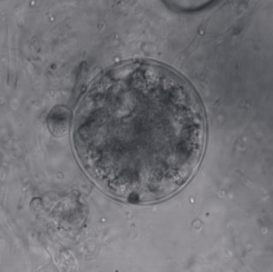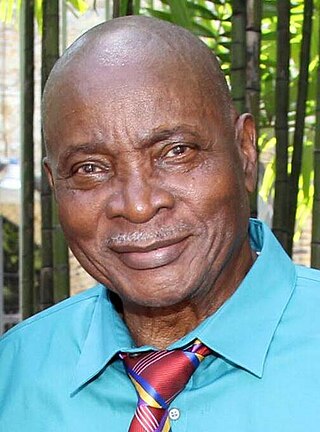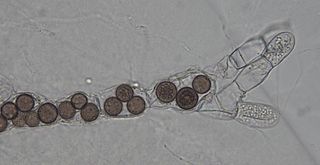
Chytridiomycota are a division of zoosporic organisms in the kingdom Fungi, informally known as chytrids. The name is derived from the Ancient Greek χυτρίδιον (khutrídion), meaning "little pot", describing the structure containing unreleased zoospores. Chytrids are one of the earliest diverging fungal lineages, and their membership in kingdom Fungi is demonstrated with chitin cell walls, a posterior whiplash flagellum, absorptive nutrition, use of glycogen as an energy storage compound, and synthesis of lysine by the α-amino adipic acid (AAA) pathway.

The house sparrow is a bird of the sparrow family Passeridae, found in most parts of the world. It is a small bird that has a typical length of 16 cm (6.3 in) and a mass of 24–39.5 g (0.85–1.39 oz). Females and young birds are coloured pale brown and grey, and males have brighter black, white, and brown markings. One of about 25 species in the genus Passer, the house sparrow is native to most of Europe, the Mediterranean Basin, and a large part of Asia. Its intentional or accidental introductions to many regions, including parts of Australasia, Africa, and the Americas, make it the most widely distributed wild bird.

Slinger Francisco ORTT CM OBE, better known as Mighty Sparrow, is a Trinidadian calypso vocalist, songwriter, and guitarist. Known as the "Calypso King of the World", he is one of the best-known and most successful calypsonians. He has won Trinidad's Carnival Road March competition eight times, Calypso King/Monarch eight times, and has twice won the Calypso King of Kings title.

Captain Jack Sparrow is a fictional character and the main protagonist of the Pirates of the Caribbean film series and franchise. An early iteration of Sparrow was created by screenwriters Ted Elliott and Terry Rossio, but the final version of the character was created by actor Johnny Depp, who also portrayed him.

Robert Kelly is an American poet associated with the deep image group. He was named the first Dutchess County poet laureate 2016-2017.

The great sparrow, also known as the southern rufous sparrow, is found in southern Africa in dry, wooded savannah and towns.

Sparrows Can't Sing is a 1963 British kitchen sink comedy film. Based on a 1960 play, Sparrers Can't Sing, it was directed by Joan Littlewood and was from a story by Stephen Lewis. The producer was Donald Taylor and the original music by James Stevens, incidental music was composed by Stanley Black. The play, also by Stephen Lewis, was first performed at Joan Littlewood's Theatre Workshop in the Theatre Royal Stratford East.

New World sparrows are a group of mainly New World passerine birds, forming the family Passerellidae. They are seed-eating birds with conical bills, brown or gray in color, and many species have distinctive head patterns.

Blastocladiomycota is one of the currently recognized phyla within the kingdom Fungi. Blastocladiomycota was originally the order Blastocladiales within the phylum Chytridiomycota until molecular and zoospore ultrastructural characters were used to demonstrate it was not monophyletic with Chytridiomycota. The order was first erected by Petersen for a single genus, Blastocladia, which was originally considered a member of the oomycetes. Accordingly, members of Blastocladiomycota are often referred to colloquially as "chytrids." However, some feel "chytrid" should refer only to members of Chytridiomycota. Thus, members of Blastocladiomyota are commonly called "blastoclads" by mycologists. Alternatively, members of Blastocladiomycota, Chytridiomycota, and Neocallimastigomycota lumped together as the zoosporic true fungi. Blastocladiomycota contains 5 families and approximately 12 genera. This early diverging branch of kingdom Fungi is the first to exhibit alternation of generations. As well, two (once) popular model organisms—Allomyces macrogynus and Blastocladiella emersonii—belong to this phylum.

Lodderena is a genus of minute sea snails or micromolluscs, marine gastropod molluscs, formerly in the family Skeneidae. Following a morphological reevaluation, it was excluded from Skeneidae and treated as incertae sedis within the superfamily Trochoidea.

Rozella is a fungal genus of obligate endoparasites of a variety of hosts, including Oomycota, Chytridiomycota, and Blastocladiomycota. Rozella was circumscribed by French mycologist Marie Maxime Cornu in 1872. Considered one of the earliest diverging lineages of fungi, the widespread genus contains 27 species, with the most well studied being Rozella allomycis. Rozella is a member of a large clade of fungi referred to as the Cryptomycota/Rozellomycota. While some can be maintained in dual culture with the host, most have not been cultured, but they have been detected, using molecular techniques, in soil samples, and in freshwater and marine ecosystems. Zoospores have been observed, along with cysts, and the cells of some species are attached to diatoms.
Passer predomesticus is a fossil passerine bird in the sparrow family Passeridae. First described in 1962, it is known from two premaxillary bones found in a Middle Pleistocene layer of the Oumm-Qatafa cave in Palestine. The premaxillaries resemble those of the house and Spanish sparrows, but differ in having a deep groove instead of a crest on the lower side. Israeli palaeontologist Eitan Tchernov, who described the species, and others have considered it to be close to the ancestor of the house and Spanish sparrows, but molecular data point to an earlier origin of modern sparrow species. Occurring in a climate Tchernov described as similar to but rainier than that in Palestine today, it was considered by Tchernov as a "wild" ancestor of the modern sparrows which have a commensal association with humans, although its presence in Oumm-Qatafa cave may indicate that it was associated with humans.
Allomyces macrogynus is a species of fungus in the family Blastocladiaceae. It was first described by mycologist Ralph Emerson in 1941 as a variety of Allomyces javanicus, and later given distinct species status in 1954. Its genome has been sequenced by the Broad Institute.

Allomyces is a genus of fungi in the family Blastocladiaceae. It was circumscribed by British mycologist Edwin John Butler in 1911. Species in the genus have a polycentric thallus and reproduce sexually or asexually by zoospores that have a whiplash-like flagella. They are mostly isolated from soils in tropical countries, commonly in ponds, rice fields, and slow-moving rivers.
Frederick Kroeber Sparrow was an American mycologist. He was known for his research on aquatic fungi, and in particular the genus Physoderma, and he produced a well-received monograph in 1943 titled The Aquatic Phycomycetes Exclusive of the Saprolegniacea and Pythium; this was republished in 1960 as Aquatic Phycomycetes.
Allomyces javanicus is a species of fungus from Indonesia.
Ralph Emerson (1912–1979) was an American botanist, academic, and professor at the University of California, Berkeley who made contributions to the fields of botany, biology, and mycology through his years of research and emphasis on aquatic and thermophilic fungi.
Allomyces cystogenus is a species of fungus in the family Blastocladiaceae. It was described as new to science in 1941 by Ralph Emerson.









